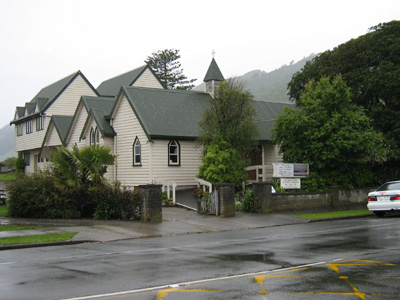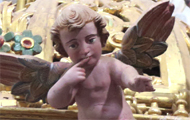 |
||||||||||
 |
||||||||||
|
1370: St Luke's, Waikanae, New Zealand Mystery Worshipper: Cherokee. The church: St Luke's, Waikanae, New Zealand. Denomination: Anglican Church in Aotearoa, New Zealand and Polynesia. The building: A 100 year old building in typical New Zealand colonial style, erected on the foundations of the original church. Behind the altar is a unique stained glass window depicting Octavius Hadfield, the missionary who built the original structure, along with St Luke and Wi Parata, the Maori chief who gave the land on which the building stands. The Parata family burial ground is adjacent to the church. The church: There are three churches in the parish of Waikanae: St Michael's at Waikanae Beach, St Luke's in the centre of the township, and St Andrew's in the Reikorangi Valley (15 minutes toward the hills from the township). Altogether they boast a congregation of about 500. Octavius Hadfield, St Luke's founder, was the first priest to be ordained in New Zealand and was reknown for his missionary work among the Maori tribe. He became Bishop of Wellington in 1870 and Primate of New Zealand in 1889. St Luke's still sees itself as an evangelical missionary church, with a congregation of all ages. The neighbourhood: Located north of Wellington on the North Island, Waikanae is said to be one of the prettiest towns in New Zealand. Deserving of its popularity as a holiday and retirement destination, the town also features outdoor sports, arts and crafts, and boating. The cast: The Rev. Hector Davis, associate minister and preacher of the first sermon; Barbara Rudd, deacon; Darryl Gardiner, non-stipendiary deacon; and the Rev. Brendon Parata, a descendant of Chief Wi Parata, who preached the second sermon. The date & time: 22 October 2006, 10.30am. What was the name of the service? Family Service. It was also a celebration of the church's 100th anniversary. How full was the building? Full to bulging. Extra chairs had been placed in the aisle and all were filled. Did anyone welcome you personally? Initially nobody welcomed us. After a few moments, a lady gave us a leaflet. A man dressed in civvies followed us in (we later learned that he was the vicar!) and, as the church was almost completely empty at the time, commented that there were plenty of seats, but did not introduce himself or utter any words of welcome. Was your pew comfortable? It was hard and not at all comfortable. How would you describe the pre-service atmosphere? A music ensemble was tuning up and people were chatting animatedly as the church filled up. What were the exact opening words of the service? Darryl Gardiner said, "Well, good morning everybody!" to which the reply was, "Good morning, Darryl!" Mr Gardiner is the national director of Youth for Christ and rather well known. What books did the congregation use during the service? Hymns for Today's Church, the New Zealand Prayer Book, the International Bible. Words to the hymns were put up on a screen via PowerPoint. What musical instruments were played? Electric keyboard and two guitars. Did anything distract you? The stained glass window behind the altar captured my attention. Was the worship stiff-upper-lip, happy clappy, or what? Informal and seriously happy clappy. It was a very vivacious celebration of the Church and of people's faith. The Lord's Prayer was recited in the Maori language.  Exactly how long was the sermon? There were two! The first lasted 14 minutes, the second 16. On a scale of 1-10, how good was the preacher? 8 – Rev. Davis had forgotten his notes and spoke from memory. He was not particularly dynamic but reasonably interesting. Rev. Parata made some good points in his sermon. In a nutshell, what was the sermon about? In the first sermon, Rev. Davis emphasised the history of the church and the relationship between the Maoris and the Christian missionaries. "We are here to worship, witness and serve," he said. The second preacher, Rev. Parata, said that St Luke's had come from a legacy, and that irrespective of the past we should look to the future. New Zealand society is comprised of two people, and our legacy for the future should be from the fusion of these two. Which part of the service was like being in heaven? The second hymn, a modern piece, was repeated several times and was sung with great gusto and genuine feeling. And which part was like being in... er... the other place? Although not advertised, a communion service was included. Unfortunately this seemed to be secondary to whatever else was going on, and as such seemed to be tacked on to the rest of the service. Also, the clergy were in formal robes because this was a special day, but this appeared at odds with the informality of the service. It might have been better if they had been dressed as they would have been 100 years ago. What happened when you hung around after the service looking lost? We hung around trying to look as lost as we could, but nobody approached us. In the end we talked to a couple who had been sitting in front of us and who had shaken hands with us during the peace. The vicar walked past us twice but did not speak either time. How would you describe the after-service coffee? An elaborate morning tea was served in typical New Zealand style, with cakes, pies and biscuits. The tea was hot and served in proper cups. We could not ascertain its provenance. How would you feel about making this church your regular (where 10 = ecstatic, 0 = terminal)? 8 – The dynamism of the congregation was infectious and they were genuinely enjoying their worship. Did the service make you feel glad to be a Christian? Yes, for the reasons given above. It was nice to see people worshipping spontaneously and unselfconsciously. What one thing will you remember about all this in seven days' time? Saying the Lord's Prayer in Maori. |
|
|
||||||||||||||||||||||||||||||||||||
| More Mystery Worshipper reports | |||||||||||||||||||||||||||||||||||||||
 |
|||||||||||||||||||||||||||||||||||||||






